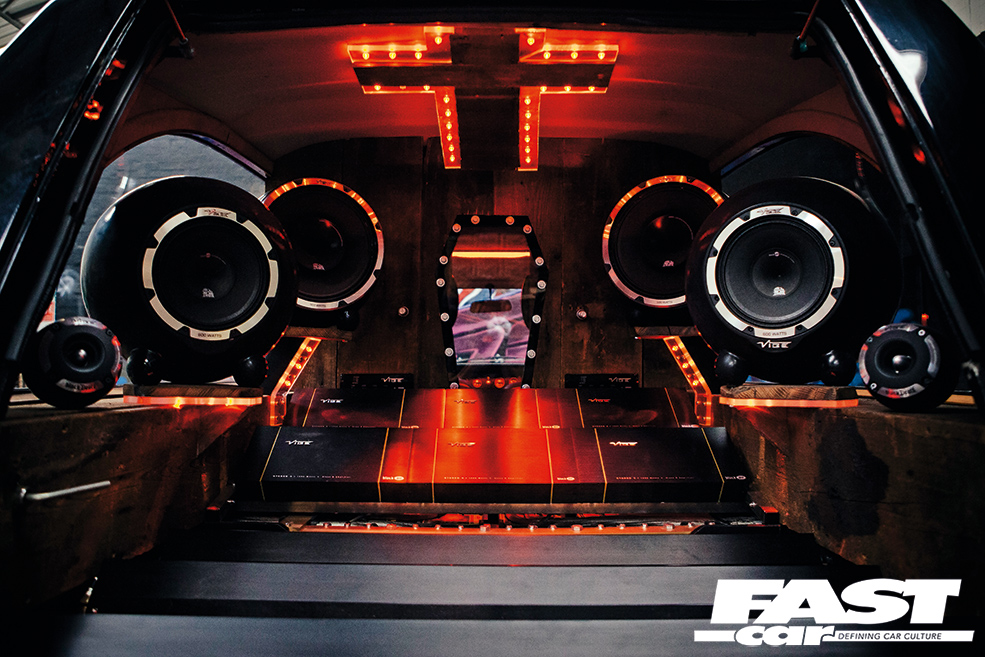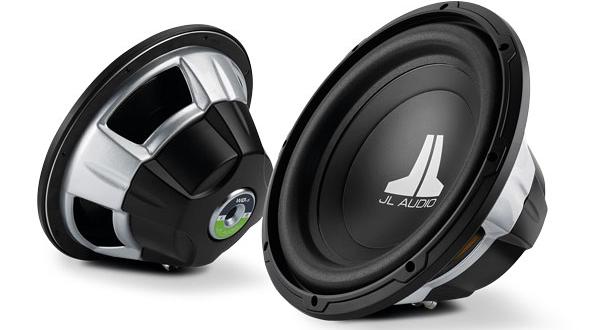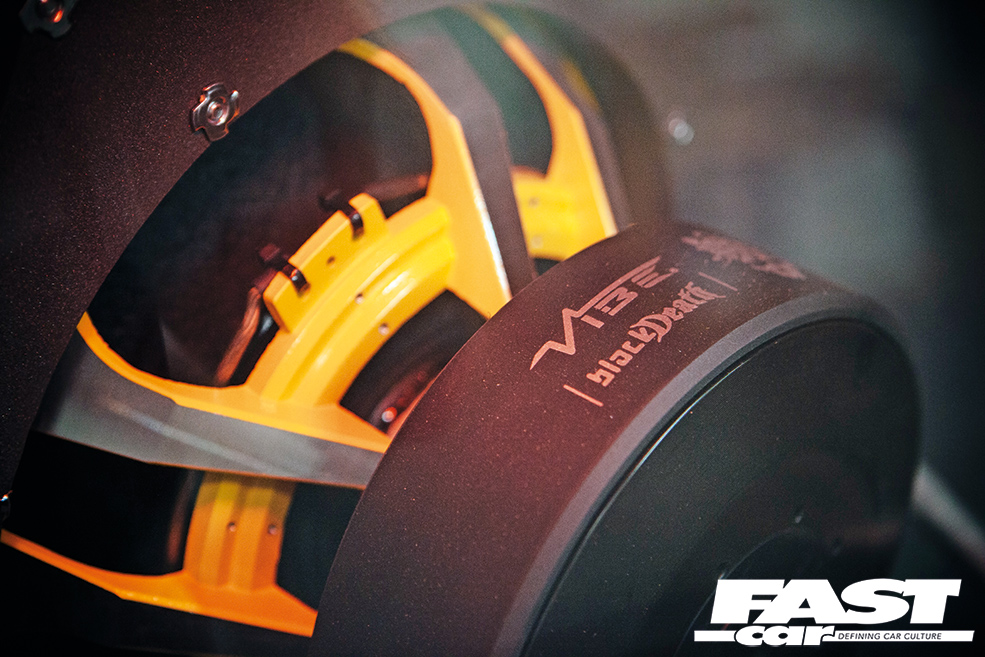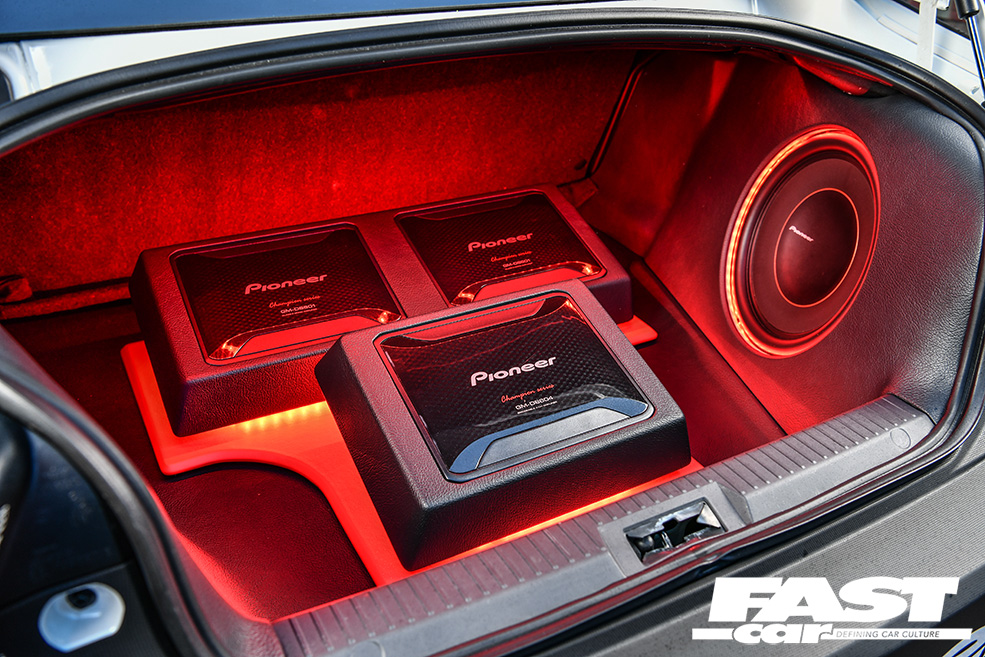Why do I need a subwoofer in my car audio system? What’s better for my car subwoofer, a bridged amp or a mono amp? What’s the best size sub to have? Find out the answers to all these questions and more in our subwoofer Q&A with JL Audio.
Our hearing can detect sounds between 20 and 20,000 Hertz and music can contain frequencies from across the entire spectrum. While the lower notes may only represent a small number of frequencies, they also require a significant amount of energy to reproduce. This energy, simply put, comes from both an amplifier and the speaker’s ability to move. Standard speakers may be able to play these notes at very low levels, but when you turn the volume up these simply cannot reproduce the sound properly and you get distortion.
A subwoofer is specifically engineered to play these lower frequencies. When set up properly, it can transform the sound of even a very basic audio system, by not only adding authority to those lower notes, but also clarity to the remaining sounds. That’s because the other speakers no longer need to struggle to reproduce everything.
When you modify a car, upgrading its audio has always been a prevalent part of the modifying process. And while we know a generous amount about modifying cars, we don’t know everything. Therefore, we sat down with Steve Turissi from car audio specialists JL Audio to answer all your questions about subwoofers.
Why do I need an amplifier to have a subwoofer?
An amplifier takes a small amount of electrical signal and makes it ‘bigger’. In the case of music, the signal is read off of a disc or from a file and the small signal is sent to an amplifier. The amplifier makes it more powerful so that it can move larger speakers.
The smaller signal may be strong enough to power earphones or very small speakers, but larger speakers will all benefit from having more power available. Subwoofers in particular will need quite a bit of power. In mobile audio all speakers need some sort of amp, be that the very basic built-in head unit item or an external unit.
Can I run a subwoofer straight off a head unit?
Scientifically speaking you can hook up a subwoofer to the wires from a head unit, but you will not get the performance from the subwoofer that it’ll be capable of delivering. So, technically, the question can be answered: yes, but you shouldn’t.
What’s better for my subwoofer, a bridged amp or a mono amplifier?
I guess I’m making dangerous assumptions here, but they are effectively the same thing. A bridged amplifier is simply the combination of two individual channels into one more powerful combined channel. Mono amplifiers are just a single channel to begin with.
The reason some multi-channel amps can be bridged is purely down to flexibility. Someone may want to use a two-channel for a pair of speakers. Some may want to run two subwoofers. And some may want to run a single more powerful subwoofer.

What’s impedance?
In electrical terms, impedance is like resistance. Resistance is the term we use in DC (direct current) circuits to describe the resistance to the flow of electricity. Music is AC (alternating current). As a result, the electrical resistance will change depending upon the frequency you play and how you play it. The 1-ohm or 4-ohm value you see rated is the nominal or average value.
As the speaker moves, the value changes. However, we may still call it a 4-ohm speaker even though the value may be anywhere between, as an example, 3.6-ohms and 60-ohms.
All amplifiers need some amount of resistance connected to them in order to function. Generally the impedance of the speaker is of no consequence to how well it may perform. The amplifier you use, however, will most likely change based upon the impedance of the subwoofer you use. Always check to make sure that the nominal impedance value of the subwoofer(s) you plan to use are within the range of values that the amplifier is rated to work with.
What does a voice coil do and why do some subs have more than one?
When you run electricity through a piece of wire, it creates a magnetic field around that wire. If you coil it up and put it near another magnet, you can make it move. Strap a cone and a frame around it all and you have a very basic speaker. The vast majority of all speakers use this moving coil design.
The vast majority of subs, if not all, use only a single voice coil, despite any names that imply otherwise. When you see ‘dual voice coil’, this is an example of lazy speech. It should actually be ‘dual voice coil connections’. This means that this single coil has two connection points. It may seem like two coils, but it’s more about configuration. These will both be in the same area of the speaker and should be wired to work together simultaneously – to work together as one coil.

Is a bigger, heavier magnet better?
A wise man once said, the right amount of magnet is the right amount of magnet. In a well-designed speaker, you should use the right amount of magnet for the design, no more and certainly no less. The weight of the magnet is not a vital specification when determining performance capability. It is about as important as the color.
In a well-engineered speaker, the magnet is part of a delicate balancing act. Too much magnetic material will often lead to a speaker that is ‘over-damped’, meaning you need more power to overcome the magnetic energy of the magnet. Not having enough magnetic material can lead to an ‘under-damped’ speaker, meaning, again in general terms, that the speaker lacks control.
Finally the reason many speakers have very heavy magnets is to do with the quality of the magnetic material. In some cases very low quality material is used and it doesn’t have the capacity needed to hold a strong magnetic charge. To make up for this, some companies will use more of the low capacity material.
What’s the most important part of the subwoofer construction?
The two most important aspects of the speaker are the designer(s) and the people that build it. That is not a joke. Since every single part of the speaker will have some significant impact on performance, it’s almost impossible to identify one part as the most important.
You might say the voice coil, but I might point out that without the magnet or the cone, the coil does nothing. Similar cases can be made for just about every singe functioning part of the speaker. It is the careful selection of the best parts for the deign that matters most, as well as how it is all put together.

What’s the best size sub to have?
The best size depends upon a few things. High on the list is how much space is available. If you are very pressed for space, a smaller subwoofer is a better option because, in general, it will need a smaller enclosure to perform well. What you don’t want to do is force a larger speaker into a less than ideal enclosure. That will compromise performance and lead to less than optimum results. It’s better to have a smaller subwoofer done right, than a larger one done wrong.
Why do subs need an enclosure?
In the most simple form, at the frequencies that a subwoofer is asked to play, it’s important to isolate the back part of the speaker from the front. Since the speaker moves in and out to reproduce the wave forms, any inward motion would effectively cancel out the outward motion if the two wave forms could meet. It’s also about supporting the woofer cone.
Many speakers are designed expecting a specific volume of air to push against. Air has a springy-ness to it that can be used as an additional suspension for the speaker. By controlling that springy-ness you can alter the performance of a speaker. If you get it wrong, the speaker can either move too far or not move far enough. When a speaker moves too far, it can fail when the surround and spider get stretched to the point that they can tear.
When a speaker can not move far enough it will struggle to play the lowest frequencies accurately as well as some other reliability issues. In short, if the manufacturer of a product specifies a certain application, there is most likely a good reason for it.

What’s the difference between sealed and ported enclosures?
Sealed boxes are simple. Build a box with a certain amount of air in it and drop the sub in. If it’s right, you get good, tight response and good power handling. If you get it wrong, you get sloppy/muddy bass or peaky/resonant bass and some reliability concerns. Pros include small size when compared to a ported enclosure. Cons include lower efficiency than other designs.
Ported boxes are a little more complicated. In addition to having to get the air volume right, you also have to get the port diameter and length right. There are a lot of variables to mess with and with such flexibility comes the chance for errors. As a result, most ported boxes are done wrong in some way. When you get them right, you are rewarded with deep, powerful and potentially louder bass than a sealed unit.
How do I know if the power ratings on a subwoofer and amplifier are true?
You’ll usually match your sub to an amplifier with a similar power rating. In real world terms, these figures can be the most misleading and misunderstood specification you’ll find. Trying to decipher what is real and what is printed to make a product look good is one of the most common problems in audio. Even the accepted term RMS, which stands for root mean square, can be misleading.
When it comes to the true power figure for an amplifier, the equation you need to know is Power (Watts) is equal to voltage (Volts) times Current (Amps). If you’re working with a car system (12 Volts) and your amp is rated at 2,000watts RMS it will need around 160amps of current. A lot more than most cars can deliver.
The easiest way to debunk power ratings is to check the fuses. If the fuse in your 1,000watt amp is say, 40amps, then you know it’s not really a 1,000watt amplifier. 480watts (12volts x 40amps) is more like the true figure.
With speakers, including subwoofers, the ratings almost seem arbitrary and in some cases just plain made up. It’s tricky to specify power for a subwoofer though. Music is dynamic, and different enclosures can impact the performance of a speaker. The best any manufacturer can really do is give a guideline as to what amount of power might be the best for most applications. Smaller subwoofers may need a bit less power, while some of the larger monsters may need more.
Is a subwoofer just for bass?
Yes. The subwoofer focuses on delivering the low frequencies, in other words, the bass. It’ll add a whole other dimension to your sound quality by delivering impress levels of bass without distorting vocals by relieving the job of low frequency deliverance from your other car speakers. That being said, if you have a thumping great subwoofer and haven’t upgraded your other car speakers, you’ll notice more bass more of the time. Great for some, but not for others. Although if you’re adding a subwoofer, you’re wanting more bass.
Relevant content:
To learn how to install one, be sure to check out our guide on how to fit a subwoofer.
The post Frequently Asked Subwoofer Questions Answered appeared first on Fast Car.
Leia Mais.